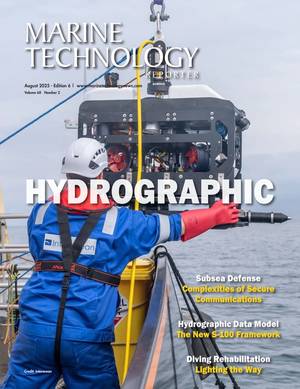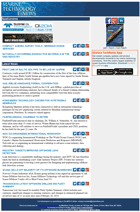NUWC Division Newport Shares Strategic Vision at Defense Innovation Days

Speaking before representatives from roughly two dozen large and small defense companies, Naval Undersea Warfare Center Division Newport Technical Director Marie Bussiere unveiled the warfare center’s 10-year strategic vision, ‘Mastery of the Seas at All Depths 2025,’ at Defense Innovation Days hosted by the Southeastern New England Defense Industry Alliance at the Newport Marriott, Aug. 25-27, 2025. (U.S. Navy photo by Nick Froment)
Naval Undersea Warfare Center (NUWC) Division Newport Technical Director Marie Bussiere unveiled the command’s 10-year strategic vision and outlined industry’s role in that initiative during a panel discussion at Southeastern New England Defense Industry Alliance (SENEDIA) Defense Innovation Days held Aug. 25-27 at the Newport Marriott.
The strategic vision, “Mastery of the Seas at All Depths 2035,” aims to expand the battlespace from the seabed to space, drive the integration of technology, and strengthen partnerships with industry to accelerate the delivery of systems and platforms to the warfighter.
Members of the panel included Division Newport’s Mark Vaccaro, director of subsea and seabed warfare (SSW); Stephen Plunkett, director of undersea warfare weapons and defensive systems; and Stephen Lamb, head of the Contracts Department; as well as Cmdr. Shawn Stelzel, head of the Capabilities Development Department at the Undersea Warfighting Development Center (UWDC).
Before the wider discussion, experts delved deeper into the Mastery of the Seas at All Depths vision and detailed a new set of Capability Focus Areas where Division Newport provides engineering and technical expertise. These include Undersea Sensing, Weapon Lethality, Assured Communications, Subsea and Seabed Warfare, Platform Defense and Survivability, Undersea Warfare Command and Control, Air-Sea Interface, Undersea Robotic and Autonomous Systems, Tactical Oceanography, Cybersecurity and Undersea Data Science and Digitization.
Technical leaders at Division Newport have refined these crucial areas and projected their progress onto Capability Evolution Plans, Bussiere said. They also developed technology roadmaps that identify key program sponsors and the performers, either at Division Newport or through its network of partners, who will execute the required work.”
One of the opportunities Bussiere mentioned was a classified-level industry day recently held at Division Newport, to address “the challenges and gaps facing the Navy and communicate the specific areas within the Capability Focus Areas that can be solved by industry.”
Before turning it over to the panelists, Bussiere provided an update on Division Newport’s efforts in the field of tactical oceanography. At Defense Innovation Days in 2024, she announced a partnership between Division Newport and the Naval Meteorology and Oceanographic Command (CNMOC).
During the panel discussion, Vaccaro was asked about barriers the Navy faces in regards to SSW, and the ways in which industry can assist in overcoming those barriers. He explained that SSW involves having a presence in places where manned platforms cannot patrol to “exploit the area and gain a military advantage.”
Getting to these areas, however, is not simple because of challenging environments and what Vaccaro called the five Ds: deep, dark, dangerous, difficult and denied.
“We need systems that have super autonomy capabilities, systems that have long endurance, systems that can swim through straits, conduct intelligence, surveillance and reconnaissance (ISR), come back, and do this in an inherently GPS-denied environment,” he said.
The Navy and industry must work alongside one another to develop technologies that meet the various SSW problem sets “at the speed of relevance,” Vaccaro said. Once the technology is developed, it needs to be brought to scale.
Plunkett, who is developing the technology roadmaps, said Division Newport leverages its internal investment portfolio to meet demand signals from the fleet and fill technological gaps.
He said many of the projects that come from the internal investment program transition to a program of record, and that “industry was involved early in transitions. NUWC is not doing it alone.”
As Division Newport looks to accelerate its technology delivery, Lamb discussed the ways in which the Contracts Department can facilitate those efforts. He pointed to the Other Transaction Authority (OTA), which allows government agencies to engage in research, development and prototype projects outside of the confines of conventional agreements.
While OTAs now make up roughly 20% of Division Newport’s contracts, Lamb said he and his staff continue to seek out best practices to create an even more agile process. He said he remains apprised on the latest special authorities, which are “coming out fast and furious,” and looks to engage with as many businesses as possible “to get more vetted players on the field.”
Maritime teamwork
Rear Adm. Pete Small, chief engineer for the Naval Sea Systems Command (NAVSEA) and commander of the Naval Surface and Undersea Warfare Centers, served as a keynote speaker at Defense Innovation Days and stressed two words during his talk: teamwork and urgency.
“True maritime superiority hinges on seamless teamwork between the U.S. Navy, our industry partners and leading academic institutions,” Small said. “This collaboration is the engine driving the development and delivery of the capabilities our nation demands.
“And urgency isn't just about rushing. It’s about prioritizing and acting decisively.”
Small said NAVSEA’s 10 warfare centers, including NUWC Division Newport, make up more than half of the Navy’s engineering and scientific expertise, and act as a “vital link between the technical community and our Sailors and Marines.” To aid in the accelerated delivery of capability, Small suggested implementing an “engineering kill chain,” where scientists and engineers use a step-by-step framework that outlines how a technical problem or vulnerability is identified, analyzed and exploited, then neutralized or fixed.
To advance this initiative, it will take teamwork. Small referenced programs that allow defense-related businesses to engage with government entities, including the Undersea Technology Innovation Consortium (UTIC), which works with Division Newport to quickly provide cutting-edge prototypes.
“Through better integration, digital tools and technical leadership, we’re strengthening our ability to deliver warfighting readiness at pace,” Small said. “We are committed to providing our Sailors with the tools they need to succeed, today and in the future. So let's work together, act with urgency, and achieve great things.”
















 August 2025
August 2025



